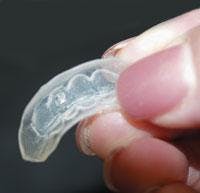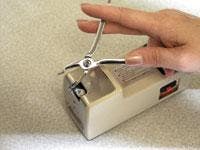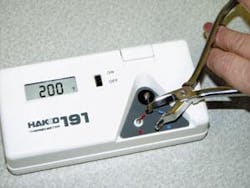Minor tooth movement
From the manufacturer - A method using Essix® Smile Aligners ...
WRITTEN BY
Thomas Spranley, DDS, MEd, FAGD
Since Dr. Henry Nahoum found a method to change tooth contours using thermoformed plastic1 in 1964, dentists have been using plastic appliances to move teeth. Today, the use of thermoformed plastic to retain and move teeth is a constant in orthodontic care. The Essix® Smile Aligner continues the evolution of the plastic appliance for tooth movement.
The versatile Essix Smile Aligner has been used for minor tooth movement (MTM since the early 1990s. 2,3,4,5 Early tooth movement called for a one-time-use appliance, which meant further adjustments required a new appliance. The Hilliard Precision Thermopliers, just like their predecessor the Essix Divoter, add a new dimension to clear appliances for tooth movement by allowing multiple adjustments to the same Essix Smile Aligner. Patients with minor misalignments, slight crowding or orthodontic relapse are ideal for Essix MTM™ (Figures 1a and 1b).
Tooth movement in plastic appliances is relatively easy. As stated in Sheridan’s First Law of Biomechanics, all tooth movement requires three things: Space + Force + Time = Tooth Movement.6,7 Plastic appliances fulfill the force part by putting pressure on teeth.
Patients with slight crowding are ideal patients for MTM.
Space refers to both interproximal and appliance space. Gaining interproximal space within the dental arch involves extraction, expansion, or removal of interproximal enamel. The less radical alternative is to remove interproximal enamel via Interproximal Reduction (IPR) or Air Rotor Stripping (ARS).8,9,10 IPR uses stainless steel strips either impregnated with diamond dust or machined with small holes to trim the enamel in a sawing type movement. Air Rotor Stripping (ARS) uses high-speed burs to reduce the proximal surface of a tooth (Figure 2).
When performing ARS/IPR, it is wise not to remove more than 1 mm of enamel from each interproximal contact (.5 mm per tooth surface maximum). ARS/IPR performed on successive interproximal spaces can gain up to 8 mm in the full arch or 2 to 3 mm in the anterior segment.11
The beauty, and the bane, of the Essix Smile Aligner is that it does not allow teeth to move unless space is present in the aligners. Without space, the tooth hits plastic and movement ceases. Therefore, space is needed for the tooth to move inside the aligner, and there are three ways to gain that space. First, prior to thermoforming, blockout compound or acrylic can be placed on the model to mimic ideal tooth orientation. Once thermoformed, this space is present in the aligner. The second way to gain space is to use one of the Hilliard Thermopliers, the Bubble-Forming Thermoplier ™ to make space in an existing Essix Smile Aligner. The third means is to cut a window into the aligner.
Force, the second requirement of Sheridan’s Law, results from placing a bump, protrusion, or intrusion in the Essix Smile Aligner (Figure 3). The plastic has a desire to remain stable in the original thermoformed position. By altering the aligner, the tooth is moved from the stability of its original position.
The placement of bumps depends on the direction and type of movement desired. Each of the 11 Hilliard Thermopliers makes a bump, protrusion, or intrusion that results in a different movement. Most teeth can be moved 3 or more mm in one aligner by using one Thermoplier or a combination of Thermopliers.
Obtaining the desired bump or protrusion is a four-step process. Step one is choosing the proper Thermoplier and adjusting its depth with the provided hex key. Bump or intrusion adjustments should be 1 mm or less since placing a longer bump or intrusion will cause the patient pain. Protrusions can be any length since they do not impact the tooth directly.
Once the depth is fixed, step two is to heat the Thermoplier in a heat source such as a Bunsen burner, blazer torch, or APT Dental Burner (Figure 4). The goal is a temperature between 175ºF and 225ºF, depending on the type of plastic and the plier involved.
The third and most important aspect of producing a bump, protrusion, or intrusion is to measure the temperature of the Thermoplier on a thermometer (Figure 5). An underheated Thermoplier will simply stretch the plastic. Stretched plastic will rapidly return to its original shape due to the pressure from the teeth, and will result in little or no tooth movement. An overheated Thermoplier will melt the plastic and cause a hole in the appliance.
The fourth and final step is to place the Thermoplier on the plastic and gently squeeze until it is tightly closed. Once the plier is closed and the plastic is formed, it can be removed and will be ready to go.
The last part of Dr. Sheridan’s equation is time. A properly placed bump, protrusion, or intrusion will move a tooth 1 mm in four weeks. However, time depends on patient compliance. Instructions to the patient are an important aspect of using the Essix Aligner. For tooth movement, patients should wear it for 24 hours a day excluding eating and cleaning times. While they are wearing a plastic appliance, patients should avoid acidic drinks such as fruit juices and colas (even diet) since any appliance will trap and hold liquid. When the liquid is acidic, undesirable changes can occur to the teeth due to the close proximity of the liquid. Allowing acidic fluids to remain in contact with the teeth can result in etching the tooth surface, staining, erosion, and possible caries.
Care of the appliance is also extremely important. Since Essix Smile Aligners are produced from crystal clear materials, patients should avoid toothpaste and toothbrushes when cleaning their appliances. Using abrasives on clear appliances will result in scratches, which will cause staining and marring of the appliance surface. Patients should use a high-quality cleaning agent such as Retainer Brite:#174;.
Recall appointments should occur every two to four weeks. These are usually short and require disinfecting the patient appliance, resetting the Thermoplier to a deeper depth, heating the Thermoplier, measuring the temperature of the Thermoplier, squeezing it closed, and delivering the appliance to the patient.
Upon completion of tooth movement, retention becomes critical. To prevent relapse, patients should wear a retainer for the rest of their lives. Retention is produced by taking a new impression and model, and from the model, thermoforming a new Essix retainer that becomes the permanent retainer. Patients should follow the same care instructions as they did with the movement aligner. However, they will now wear the retainer at night only for a minimum of eight hours. If the patient had extreme rotation of teeth prior to movement, a bonded retainer is recommended. In this case, the Essix retainer becomes a secondary retention device since failure of bonded retainers is common.
The cost of moving teeth in an Essix Smile Aligner is minimal. The cost includes impressions, pouring models, blocking out the model (unless using a window), thermoforming material to the model, placing the bump, protrusion, or intrusion with the Thermoplier, and delivering the appliance to the patient. Most of the procedure can be performed by a qualified dental assistant working from a prescription form provided by the doctor. The procedures can be easily accomplished in the dental office without outside laboratory costs.
Essix MTM technology is an alternative method of moving teeth with plastic appliances. No brackets or wires makes this an acceptable solution for patients who want their teeth corrected, but do not want the look of braces. Essix MTM is affordable for the patient and can be lucrative for the doctor. ■
References
1 Nahoum H. The vacuum-formed dental contour appliance. New York State Dental Journal 1964; 30:385-390.
2 Sheridan J, Ledoux W, McMinn R. (1994). Essix technology for the fabrication of temporary anterior bridges. Journal of Clinical Orthodontics 1994; 28:482-486.
3 Ballard R, Sheridan J. Air-rotor stripping with the Essix Anterior Anchor. Journal of Clinical Orthodontics 1996; 30:371.
4 Sheridan J. The updated air-rotor stripping (ARS) manual (in review). 2005; New Orleans: Raintree Essix LLC.
5 Sheridan J, Armbruster P, Nguyen P, Pulitzer S. Tooth movement with Essix mounding. Journal of Clinical Orthodontics 2004; 38:435-441.
6 Sheridan J, Hilliard K, Armbruster P. Essix appliance technology: applications, fabrication, and rationale. GAC International, Inc. 2003.
7 Hilliard K. The hilliard smile aligner manual. 2002; New Orleans: Raintree Essix LLC.
8 Sheridan J. Air-rotor stripping. Journal of Clinical Orthodontics 1985; 19:43-59.
9 Sheridan J. Air-rotor stripping update. Journal of Clinical Orthodontics 1987; 21:781-788.
10 Sheridan J. The physiological rationale for air-rotor stripping. Journal of Clinical Orthodontics 1997; 31:609-612.
11 Spranley T. Minor tooth movement technology: part 1 bodily movement. Spectrum 2005; 4:106-110.
Thomas Spranley, DDS, MEd, FAGD Dr. Spranley is the director of clinical operations for Raintree Essix, Inc., a division of Dentsply International. A fellow in the AGD, he lectures and conducts training seminars worldwide on the methods taught and developed by Drs. Keith Hilliard and Jack Sheridan. You may contact Dr. Spranley at [email protected].






